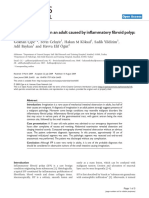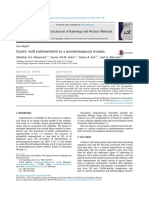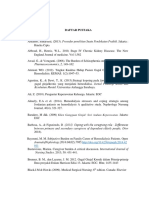A Case of Peutz-Jegher Syndrome
A Case of Peutz-Jegher Syndrome
Uploaded by
RahmadianiPutriNasutionCopyright:
Available Formats
A Case of Peutz-Jegher Syndrome
A Case of Peutz-Jegher Syndrome
Uploaded by
RahmadianiPutriNasutionOriginal Description:
Original Title
Copyright
Available Formats
Share this document
Did you find this document useful?
Is this content inappropriate?
Copyright:
Available Formats
A Case of Peutz-Jegher Syndrome
A Case of Peutz-Jegher Syndrome
Uploaded by
RahmadianiPutriNasutionCopyright:
Available Formats
A CASE OF PEUTZ-JEGHER SYNDROME
MajSMEHROTRA *,LtCoIPSENGUPTA +,
Maj CG MURLIDHARAN #
MJAFI 1999; 55 : 253-254
KEY WORDS: Intestinal obstruction; Peutz-jegher syndrome.
Introduction Case Report
A
An 18-year-old was admitted with 3 day history of abdomen
n autosomal dominant disorder, Peutz-Jegher pain, vomiting, distension and constipation. He was operated in
syndrome is characterized by hamartomatous 1985 for ileocecal intussusception resulting from a polyp and was
polyposis of the gastrointestinal tract. It is asymptomatic thereafter. Clinical examination revealed a thin boy
distinguished from other polyposis syndromes by the with distended abdomen having visible peristalsis. He also had
melanotic pigmentation of lips and palms. (Fig 1,2) Plain X-ray of
classical mucocutaneous pigmentation [1]. We report the abdomen revealed multiple air fluid levels. Biochemical and
here an eighteen year old boy who developed intesti- haematological parameters were normal. Conservative treatment
nal obstruction twice over a period of 13 years and did not succeed and he was subjected to laparotomy after five
required multiple laparotomies. days.
Surgery revealed a densely contracted mesentry with interloop
adhesions. A dense stricture causing obstruction at the ileocaecal
junction was resected and end to end anastomosis performed. Mul-
tiple large polyps were palpable in the proximal jejunum and re-
moved via enterotomies. The patient had an uneventful postopera-
tive recovery. Histopathological examination of the polyps re-
vealed hamartomatous features. There were hypertrophic bands of
muscularis mucosae enclosing islands of normal intestinal glands
containing goblet cells. (Fig 3). HPE of stricture showed gross
fibrotic thickening.
Postoperative barium meal follow through and enema of the
patient did not reveal any remaining polyp. His two siblings nei-
ther had any melanotic pigmentation nor any polyp on radiological
investigation.
Discussion
Gastorintestinal polyposis syndromes are rare he-
reditary disorders. They commonly present with
bleeding or intermittent small bowel obstruction [2].
Fig. 1: Melanotic pigmentation of lips Fig. 2: Melanotic pigmentation of palms
* Surgeon, + Pathologist, # Radiologist, Military Hospital, Yol.
254 Mehrotra, Sengupta and Murlidharan
pancreas, breast and lung. Ovarian and testicular tu-
mours may also develop with greater frequency in
these patients and need appropriate treatment [7]. Our
patient presented with intussuception in 1985 when
the syndrome was not evident. The nature of the polyp
was reported as being angiomatous. During the pre-
sent exploration multiple proximal jejunal polyps were
found apart from the fibrotic narrowing at the site of
previous surgery. It needs to be stressed that radical
removal of the polyps must be the aim of surgery.
Patients need to be closely followed by examination,
endoscopy and radiological investigations to avoid the
complications of regrowth and detect malignant de-
Fig. 3: Hamartomatous polyposis of gastrointestinal tract
generation.
Many familial polyposis are transmitted as autosomal REFERENCES
dominant traitS. The classical melanotic pigmentation 1. Imbembo AL, Fitzpatrick JC. Benign neoplasm of the colon.
of Peutz-Jegher syndrome immediately distinguishes it In: Sabiston DC. Ed.Text book of surgery. Philadelphia:
from other forms of polyposis. Seven cases of Peutz- WB saunders 1991:925.
Jegher syndrome were found over a study period of 3 2. Leaper DJ. Tumours of the colon. In: Schwartz SI, Ellis H,
Eds. Maingot's abdominal operations. LondOfl: Prentice Hall
years among 103 children with gastrointestinal poly-
International Inc 1990:1033-40.
posis in Taiwan [3]. The average age of diagnosis is
3. Ko FY, Wu Te, Hwan B. Intestinal polyps in children and
the third decade with no racial predisposition. Our pa- a40lescents-A review of 103 cases. Acta Paediatr Sin
tient did not have pigmentation earlier during initial 1~5;3~3): 197-202.
presentation in 1985 and manifested when he was 7-8 4. Spegehnaft AD, Arese P, Phillips RK. PQlypOsis:the·Peutz-
years old. The tendency to have recurrent obs.truction Jegll$' syndro~. Br J SUrg 1995;822(10):1311.-4
and complication requiring repeated laparotomies is 5. Loft'S, WesSelL, Wirth H,. et al: Peutz-Jegher syndrome-
less appreciated than the disorder [4]. In addition, op- Cases at the Mainheim clinic over 25 years. LaDgenbecks
erations frequently involve complications and need to Arch C1)ir 1995;380(1):43-52.
be repeated [5]. Radical removal of all polyps must be 6. Miyahara M. Saito T. Etoeh Ie et al. Appendiceal intus-
the aim of treatment. sU$ception due to an appendiceal malignant pol~an associa-
tiori in a patient with Peutz-Jegher syndromc:report of a case.
Though Peutz-Jehger polyps cannot be regarded as Surg Today 1995;25(9):834-7.
premalignant, associated adenomatous polyps with 7. Wilson DM, Pitts WC, Mintz RL, Rosenfield RO. Testicular
high malignant potential can co-exist [6]. There is an tumours with Peutz-Jegher syndrome. Cancer 1986;57:22-38.
increased risk of developing carcinomas involving
MJAFI. VOL 55. NO.3. 1999
You might also like
- Complications of Spinal and Epidural AnesthesiaNo ratings yetComplications of Spinal and Epidural Anesthesia45 pages
- Jejunal Invagination in An Adult Caused by Inflammatory Fibroid Polyp: A Case ReportNo ratings yetJejunal Invagination in An Adult Caused by Inflammatory Fibroid Polyp: A Case Report3 pages
- Case Series of Unusual Causes Intestinal Obstruction in Infants and ChildrenNo ratings yetCase Series of Unusual Causes Intestinal Obstruction in Infants and Children9 pages
- Duplication Cyst of Pyloric Canal: A Rare Cause of Pediatric Gastric Outlet Obstruction: Rare Case ReportNo ratings yetDuplication Cyst of Pyloric Canal: A Rare Cause of Pediatric Gastric Outlet Obstruction: Rare Case Report4 pages
- Ileo-Sigmoid Knot, A Rare Etiology of Occlusion: About 3 CasesNo ratings yetIleo-Sigmoid Knot, A Rare Etiology of Occlusion: About 3 Cases3 pages
- Vitellointestinal Duct Anomalies in InfancyNo ratings yetVitellointestinal Duct Anomalies in Infancy3 pages
- Obstructive Ileus Due To A Giant Fibroepithelial Polyp of The AnusNo ratings yetObstructive Ileus Due To A Giant Fibroepithelial Polyp of The Anus4 pages
- An Unusual Presentation of Peutz-Jeghers Syndrome:: Case of Recurrent Jejunal IntussusceptionNo ratings yetAn Unusual Presentation of Peutz-Jeghers Syndrome:: Case of Recurrent Jejunal Intussusception4 pages
- Paper Presentation On Trichobezoars A Hairy Cause of Intestinal ObstructionNo ratings yetPaper Presentation On Trichobezoars A Hairy Cause of Intestinal Obstruction14 pages
- A Rare Case of A Giant Cystic Leiomyoma Presenting As ANo ratings yetA Rare Case of A Giant Cystic Leiomyoma Presenting As A4 pages
- Tumors of The Amputla: Pathogenesis and Prognostic Factors: PathogensNo ratings yetTumors of The Amputla: Pathogenesis and Prognostic Factors: Pathogens3 pages
- Occlusion On Congenital Mesenteric Bridge in Children About CaseNo ratings yetOcclusion On Congenital Mesenteric Bridge in Children About Case3 pages
- Unusual Presentation of Recurrent Appendicitis - A Rare Case Report and Literature ReviewNo ratings yetUnusual Presentation of Recurrent Appendicitis - A Rare Case Report and Literature Review4 pages
- Pseudoneoplasms of The Gastrointestinal TractNo ratings yetPseudoneoplasms of The Gastrointestinal Tract15 pages
- Case Series of Intussusception in Paediatric SurgeryNo ratings yetCase Series of Intussusception in Paediatric Surgery39 pages
- Carcinoma of Stomach Detected by Routine Transabdominal UltrasoundNo ratings yetCarcinoma of Stomach Detected by Routine Transabdominal Ultrasound3 pages
- Brown Bowel Syndrome, An Unusual Cause of Sigmoid VolvulusNo ratings yetBrown Bowel Syndrome, An Unusual Cause of Sigmoid Volvulus3 pages
- Enterolith Ileus in A Patient With Jejunal Diverticulosis, Sonographic FindingsNo ratings yetEnterolith Ileus in A Patient With Jejunal Diverticulosis, Sonographic Findings5 pages
- Benign Multicystic Peritoneal Mesothelioma: A Case Report: Casereport Open AccessNo ratings yetBenign Multicystic Peritoneal Mesothelioma: A Case Report: Casereport Open Access5 pages
- 8.8 Mesenteric Cystic Lymphangioma in Pediatric Patient - A Rare Intra-Abdominal Tumor Management in Rural Country Case ReportNo ratings yet8.8 Mesenteric Cystic Lymphangioma in Pediatric Patient - A Rare Intra-Abdominal Tumor Management in Rural Country Case Report5 pages
- A Huge Trichobezoar in The Jejunum: Ho Kyung Lim, M.D., Young Ok Kim, M.D. and Young Jong Woo, M.DNo ratings yetA Huge Trichobezoar in The Jejunum: Ho Kyung Lim, M.D., Young Ok Kim, M.D. and Young Jong Woo, M.D3 pages
- Cap Polyposis in Children: Case Report and Literature ReviewNo ratings yetCap Polyposis in Children: Case Report and Literature Review6 pages
- Mesenteric Cyst Infected With: Salmonella TyphimuriumNo ratings yetMesenteric Cyst Infected With: Salmonella Typhimurium2 pages
- A Case Report of Perforated Primary Follicular Lymphoma of The Jejunum Presenting As Aneurismal FormNo ratings yetA Case Report of Perforated Primary Follicular Lymphoma of The Jejunum Presenting As Aneurismal Form3 pages
- 1999-07 - Intraductal Papillary-Mucinous Tumor of The Pancreas - Presentation in A Young Adult PDFNo ratings yet1999-07 - Intraductal Papillary-Mucinous Tumor of The Pancreas - Presentation in A Young Adult PDF4 pages
- Delayed Diagnosis of Duodenal Atresia in An 11 Year Old: Case ReportNo ratings yetDelayed Diagnosis of Duodenal Atresia in An 11 Year Old: Case Report6 pages
- Rare Presentation of Mycobacterium Avium-Intracellulare InfectionNo ratings yetRare Presentation of Mycobacterium Avium-Intracellulare Infection3 pages
- Adhesive Intestinal Obstruction. What A Resident Should KnowNo ratings yetAdhesive Intestinal Obstruction. What A Resident Should Know6 pages
- Pneumatosis Cystoides Intestinalis: Report of Two Cases: M. Turan, M. S En, R. EgılmezNo ratings yetPneumatosis Cystoides Intestinalis: Report of Two Cases: M. Turan, M. S En, R. Egılmez3 pages
- Acquired Colonic Atresia in A 4-Month Old Term Male Infant: A Rare Case ReportNo ratings yetAcquired Colonic Atresia in A 4-Month Old Term Male Infant: A Rare Case Report3 pages
- Alves2007 Article PleomorphicMulticentricAdenomaNo ratings yetAlves2007 Article PleomorphicMulticentricAdenoma3 pages
- Kulkarni Magee 2005 Rectal Prolapse in A Young Adult Male Patient and Its Unique AetiologyNo ratings yetKulkarni Magee 2005 Rectal Prolapse in A Young Adult Male Patient and Its Unique Aetiology1 page
- Gastric Volvulus Through Morgagni Hernia and Intestinal Diverticulosis in An Adult Patient: A Case ReportNo ratings yetGastric Volvulus Through Morgagni Hernia and Intestinal Diverticulosis in An Adult Patient: A Case Report5 pages
- Electroacupuncture: An Introduction and Its Use For Peripheral Facial ParalysisNo ratings yetElectroacupuncture: An Introduction and Its Use For Peripheral Facial Paralysis19 pages
- الوصفة الطبية للعلاج بالتغذية جيمس ف. بالش المكتبة نتNo ratings yetالوصفة الطبية للعلاج بالتغذية جيمس ف. بالش المكتبة نت705 pages
- Hasil SWAB Antigen - RINALDI - RANGGA - SAPUTRA PDFNo ratings yetHasil SWAB Antigen - RINALDI - RANGGA - SAPUTRA PDF1 page
- 5-Exposição Continua Aos Químicos Da DietaNo ratings yet5-Exposição Continua Aos Químicos Da Dieta32 pages
- "Central Giant Cell Granuloma" - An Update: Invited ReviewNo ratings yet"Central Giant Cell Granuloma" - An Update: Invited Review3 pages
- Hepatitis A Virus Transmission in A Dental Clinic SettingNo ratings yetHepatitis A Virus Transmission in A Dental Clinic Setting2 pages
- Clinical Features of Intracranial Vestibular SchwannomasNo ratings yetClinical Features of Intracranial Vestibular Schwannomas6 pages
- Rossi's Principles of Transfusion Medicine 6th EditionNo ratings yetRossi's Principles of Transfusion Medicine 6th Edition719 pages
- Daftar Harga Pt. Antera Kalibrasi 2021 PDFNo ratings yetDaftar Harga Pt. Antera Kalibrasi 2021 PDF2 pages
- Admitting Conference: Abejo, Jerika D. Bona, Henry JR.No ratings yetAdmitting Conference: Abejo, Jerika D. Bona, Henry JR.38 pages
- (Advances in Food and Nutrition Research Volume 73) Kim, Se-Kwon-Marine Carbohydrates - Fundamentals and Applications, Part B-ANo ratings yet(Advances in Food and Nutrition Research Volume 73) Kim, Se-Kwon-Marine Carbohydrates - Fundamentals and Applications, Part B-A291 pages
- International Journal of Current Advanced Research International Journal of Current Advanced ResearchNo ratings yetInternational Journal of Current Advanced Research International Journal of Current Advanced Research4 pages

























































































